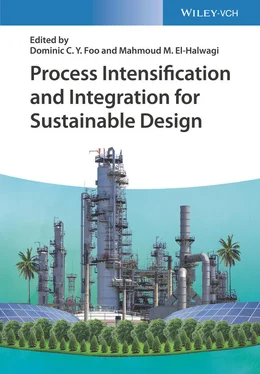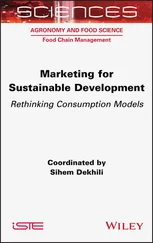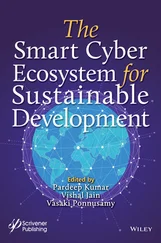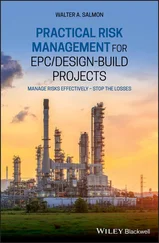9 4 Techno‐economic and Environmental Assessment of Ultrathin Polysulfone Membranes for Oxygen‐Enriched Combustion 4.1 Introduction 4.2 Numerical Methodology for Membrane Gas Separation Design 4.3 Methodology 4.4 Results and Discussion 4.5 Conclusion Acknowledgment References
10 5 Process Intensification of Membrane‐Based Systems for Water, Energy, and Environment Applications 5.1 Introduction 5.2 Membrane Electrocoagulation Flocculation for Dye Removal 5.3 Carbonation Bioreactor for Microalgae Cultivation 5.4 Forward Osmosis and Electrolysis for Energy Storage and Treatment of Emerging Pollutant 5.5 Conclusions and Future Perspective References
11 6 Design of Internally Heat‐Integrated Distillation Column (HIDiC) 6.1 Introduction 6.2 Example and Conceptual Design of Conventional Column 6.3 Basic Design of HIDiC 6.4 Complete Design of HIDiC 6.5 Energy Savings and Economic Evaluation 6.6 Concluding Thoughts References
12 7 Graphical Analysis and Integration of Heat Exchanger Networks with Heat Pumps 7.1 Introduction 7.2 Influences of Heat Pumps on HENs 7.3 Integration of Heat Pump Assisted Distillation in the Overall Process 7.4 Case Study 7.5 Conclusion References
13 8 Insightful Analysis and Integration of Reactor and Heat Exchanger Network 8.1 Introduction 8.2 Influence of Temperature Variation on HEN 8.3 Relation Among Reactor Parameters 8.4 Coupling Optimization of HEN and Reactor 8.5 Case Study 8.6 Conclusions References
14 9 Fouling Mitigation in Heat Exchanger Network Through Process Optimization 9.1 Introduction 9.2 Operation Parameter Optimization for Fouling Mitigation in HENs 9.3 Optimization of Cleaning Schedule 9.4 Application of Backup Heat Exchangers 9.5 Optimization Constraints and Objective Function 9.6 Case Studies 9.7 Conclusion Acknowledgments References
15 10 Decomposition and Implementation of Large‐Scale Interplant Heat Integration 10.1 Introduction 10.2 Methodology 10.3 Case Study 10.4 Conclusion References
16 11 Multi‐objective Optimisation of Integrated Heat, Mass and Regeneration Networks with Renewables Considering Economics and Environmental Impact 11.1 Introduction 11.2 Literature Review 11.3 Environmental Impact in Process Synthesis 11.4 The Synthesis Method and Model Formulation 11.5 Case Study 11.6 Conclusions and Future Works References
17 12 Optimization of Integrated Water and Multi‐regenerator Membrane Systems Involving Multi‐contaminants: A Water‐Energy Nexus Aspect 12.1 Introduction 12.2 Problem Statement 12.3 Model Formulation 12.4 Illustrative Example 12.5 Conclusion Acknowledgments 12.A Appendix: Detailed Models for the ED and RO Modules Nomenclature References
18 13 Optimization Strategies for Integrating and Intensifying Housing Complexes 13.1 Introduction 13.2 Methods 13.3 Case Study 13.4 Results 13.5 Conclusions References
19 14 Sustainable Biomass Conversion Process Assessment 14.1 Introduction 14.2 Methodology and Assumptions 14.3 Results and Discussion 14.4 Conclusions Acknowledgments References
20 Index
21 End User License Agreement
1 Chapter 1 Table 1.1 Major shale gas plays in the United States. Table 1.2 Recent shale gas reserves and production in for the six countries w... Table 1.3 Reforming options and their characteristics.
2 Chapter 2 Table 2.1 Feed types as determined by methane composition. Table 2.2 Selected cases. Table 2.3 High acid (HA) gas feed composition. Table 2.4 Parameters used for the techno‐economic analysis. Table 2.5 Price of different commodities. Table 2.6 Effective prices for products ($/gal). Table 2.7 Return on investment for the base case. Table 2.8 Incremental return on investment for high acid case. Table 2.9 Results from modified process route index calculations. Table 2.10 Maximum, minimum, average, and standard deviation for price data. Table 2.11 Description of Cases 1–3 for sensitivity analysis. Table 2.12 Description of cases for sensitivity analysis. Table 2.A.1 Dehydration column parameters for the base case (Feed #3). Table 2.A.2 Makeup composition for the base case (Feed #3). Table 2.A.3 Glycol circulation rate for the base case (Feed #3). Table 2.B.1 Demethanizer column parameters. Table 2.B.2Low temperature separator (LTS) inlet temperature. Table 2.B.3 Outlet pressure for the pressure changing equipment. Table 2.C.1 Fractionation train column parameters for the base case (Feed #3)... Table 2.D.1 Acid gas removal column parameters. Table 2.D.2 Makeup composition. Table 2.D.3 Key heat exchange equipment outlet temperatures.
3 Chapter 4Table 4.1 Values of constants determined from curve fitting with revised Dool...Table 4.2 Values of physical parameters for solubility–thickness empirical eq...
4 Chapter 5Table 5.1 Comparative analysis of bubble size and total contact area produced...
5 Chapter 6Table 6.1 Simulation results of conventional column.Table 6.2 Reboiler and condenser duty of HIDiC basic design.Table 6.3 Temperature profile for rectifying and stripping columns.Table 6.4 Calculation of Q iand A ifor top‐integrated column configuration.Table 6.5 Calculation of Q iand A ifor bottom‐integrated column configuration....Table 6.6 Geometrical analysis of heat panels.Table 6.7 Energy savings and economic evaluation of different column configur...
6 Chapter 7Table 7.1 Summary of cases 1–7.Table 7.2 Stream data of the process.
7 Chapter 8Table 8.1 Variation of energy consumptions for exothermic reaction.Table 8.2 Variation of energy consumptions for endothermic reaction.
8 Chapter 9Table 9.1 Streams data for Case Study 1.Table 9.2 Heat exchangers data for Case Study 1.Table 9.3 Stream split ratio in the base and optimized case (the split ratio ...Table 9.5 Economic efficiency in different cases (Case Study 1).Table 9.4 Cost related data (Case Study 1).Table 9.6 Design and operation parameters for Case Study 2.Table 9.7 Cost and physical related data (Case Study 2).Table 9.8 Optimized cleaning schedules for Scenario 1.Table 9.9 Optimized cleaning schedules for Scenario 3.Table 9.10 Fouling rate of different scenarios at hot end of the network.Table 9.11 Summary of optimized results for selected scenarios.Table 9.12 Cleaning schedule with back‐up heat exchangers.
9 Chapter 10Table 10.1 The stream data of Example 1.Table 10.2 The IPHI implementation result of Example 1.Table 10.3 The stream data of Example 2.Table 10.4 Comparisons between the designs by utilizing different methods fro...
10 Chapter 11Table 11.1 The MEN stream data (concentrations given in mass fractions).Table 11.2 The REN stream data (compositions given in mass fractions).Table 11.3 The capital costs of different networks.Table 11.4 Operating costs of lean, regenerating, and utility streams.Table 11.5 The environmental impact of lean and regenerating streams for H 2S ...Table 11.6 The HEN stream data for H 2S removal process.Table 11.7 NMP lean stream data.Table 11.8 The inert gas stripping stream data.
11 Chapter 12Table 12.1 Process data for water network.Table 12.2 Economic data for case study.Table 12.3 Summary of results for all scenarios based on case study.Table 12.4 Summary of regeneration cost analysis.Table 12.5 Summary of model characteristics for all scenarios.
12 Chapter 13Table 13.1 Eco‐points for energy and resources for the proposed system [15].Table 13.2 Eco‐points for the used material in the technologies production.Table 13.3 Parameters to calculate the occupation health.Table 13.4 Utopia and Nadir points for the random scenarios.Table 13.5 Individual and total dissatisfaction for the proposed scenarios.Table 13.6 Individual objective solutions for the scenario with lowest dissat...
13 Chapter 14Table 14.1 Key performance metrics comparison for the DME‐to‐HOG catalyst.Table 14.2 Primary input data for economic indicator calculation.Table 14.3 Material and energy flows for the syngas conversion process (gate‐...Table 14.4 GREENSCOPE environmental indicators.Table 14.5 GREENSCOPE energy indicators.Table 14.6 GREENSCOPE material efficiency indicators.Table 14.7 GREENSCOPE economic indicators.
Читать дальше












